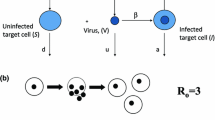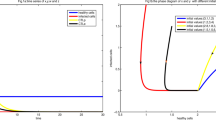Abstract
Cytotoxic T lymphocytes (CTLs) are immune system cells that are thought to play an important role in controlling HIV infection. We develop a stochastic ODE model of HIV–CTL interaction that extends current deterministic ODE models. Based on this stochastic model, we consider the effect of CTL attack on intrahost HIV lineages assuming that CTLs attack several epitopes with equal strength. In this setting, we introduce a limiting version of our stochastic ODE under which we show that the coalescence of HIV lineages can be described through Poisson–Dirichlet distributions. Through numerical experiments, we show that our results under the limiting stochastic ODE accurately reflect HIV lineages under CTL attack when the HIV population size is on the low end of its hypothesized range. Current techniques of HIV lineage construction depend on the Kingman coalescent. Our results give an explicit connection between CTL attack and HIV lineages.











Similar content being viewed by others
References
Asmussen, S., & Glynn, P. W. (2007). Stochastic simulation, algorithms and analysis. Stochastic modeling and applied probability. Berlin: Springer.
Athreya, K. B., & Ney, P. E. (1972). Branching processes. Berlin: Springer.
Barton, N. H., et al. (2004). Coalescence in a random environment. Ann. Appl. Probab., 14, 754–785.
Bertoin, J. (1996). Levy processes. Cambridge tracts in mathematics.
Borrow, P. H., et al. (1994). Virus-specific cd8+ cytotoxic t-lymphocyte activity associated with control of viremia in primary human immunodeficiency virus type 1 infection. J. Virol., 68, 6103–6110.
Carrington, M., & O’Brien, S. J. (2003). The influence of HLA genotype on AIDS. AIDS Annu. Rev. Med., 54, 535–551.
Crandall, K. A. (1999). The evolution of HIV. Baltimore: Johns Hopkins University Press.
Darling, R. W. R., & Norris, J. R. (2008). Differential equation approximations for Markov chains. Probab. Surv., 5, 37–79.
DeFranco, A. L., Locksley, R. M., & Robertson, M. (2007). Immunity: the immune response in infectious and inflammatory disease. London: New Science Press.
Drummond, A. J., & Rambaut, A. (2007). Beast: Bayesian evolutionary analysis by sampling trees. BMC Evol. Biol., 7, 214.
Bertoin, J., & Le Gall, J.-F. (2000). The Bolthausen–Sznitman coalescent and the genealogy of continuous-state branching processes. Probab. Theory Relat. Fields, 117, 249–266.
Bolthausen, E., & Sznitman, A.-S. (1998). On Ruelle’s probability cascades and an abstract cavity method. Commun. Math. Phys., 197, 247–286.
Leigh-Brown, A. J. (1997). Analysis of HIV-1 env gene sequences reveals evidence for a low effective number in the viral population. Proc. Natl. Acad. Sci. USA, 94, 1862–1865.
Chun, T.-W., et al. (1997). Quantification of latenet tissue reservoirs and total body viral load in HIV-1 infection. Nature, 387, 183–188.
Desai, M. M., & Fisher, D. S. (2007). Beneficial mutation-selection balance and the effect of linkage on positive selection. Genetics, 176, 1759–1798.
Drummond, A. J., & Rodrigo, A. G. (2000). Reconstructing genealogies of serial samples under the assumption of a molecular clock using serial-sample UPGMA. Mol. Biol. Evol., 17, 1807–1815.
Durrett, R., et al. (2009). A waiting time problem arising from the study of multi-stage carcinogenesis. Ann. Appl. Probab., 19(2), 676–718.
Durrett, R., & Schweinsberg, J. (2004). Approximating selective sweeps. Theor. Popul. Biol., 66, 129–138.
Goonetilleke, N., et al. (2009). The first t cell response to transmitted/founder virus contributes to the control of acute viremia in HIV-1 infection. J. Exp. Med., 206(6), 1253–1272.
Hermisson, J., & Pennings, P. S. (2005). Soft sweeps: molecular population genetics of adaptation from standing genetic variation. Genetics, 169, 2335–2352.
Iwasa, Y., et al. (2005). Population genetics of tumor suppressor genes. J. Theor. Biol., 233, 15–23.
Kaplan, N. L., et al. (1988). The coalescent process in models with selection. Genetics, 120, 819–829.
Kelleher, A. D., et al. (2001). Clustered mutations in HIV-1 gag are consistently required for escape from hla-b27-restricted cytotoxic t lymphocyte responses. J. Exp. Med., 193, 375–386.
Kepler, T. B., & Oprea, M. (2001). Improved inference of mutation rates: I. An integral representation for the Luria–Delbruck distribution. Theor. Popul. Biol., 59, 41–48.
Koup, R. A., et al. (1994). Temporal association of cellular immune responses with the initial control of viremia in primary human immunodeficiency virus type 1 syndrome. J. J. Virol., 68, 4650–4655.
Kouyos, R. D., et al. (2006). Stochastic or deterministic: what is the effective population size of HIV-1. Trends Microbiol., 14(12), 507–511.
Kuhner, M. K. (2006). Lamarc 2.0: maximum likelihood and Bayesian estimation of population parameters. Bioinformatics, 22(6), 768–770.
Kurtz, T. (1981). Approximation of population processes. CBMS-NSF regional conference series in applied mathematics, vol. 36.
Leviyang, S. (2012). Sampling HIV intrahost genealogies based on a model of acute stage CTL response. Bull. Math. Biol., 74(3), 509–535.
Leviyang, S. (2011, in press). Analysis of a stochastic predator–prey model with applications to intrahost HIV genetics. J. Math. Biol., doi:10.1007/s00285-011-0497-2
Levy, J. A. (1998). HIV and the pathogenesis of AIDS (2nd ed.). Washington: ASM Press.
Mohle, M. (2005). Convergence results for compound Poisson distributions and applications to the standard Luria–Delbruck distribution. J. Appl. Probab., 42(3), 620–631.
Nolan, J. P. (2011). Stable distributions—models for heavy tailed data. Boston: Birkhäuser. In progress, Chapter 1 online at academic2.american.edu/~jpnolan.
Nowak, M. A., & May, R. M. (2000). Virus dynamics: mathematical principles of immunology and virology. London: Oxford University Press.
Pennings, P. S., & Hermisson, J. (2006). Soft sweeps II: molecular population genetics of adaptation from recurrent mutation or migration. Mol. Biol. Evol., 23(5), 1076–1084.
Perelson, A. S. (2002). Modeling viral and immune system dynamics. Nat. Rev., 2, 28–36.
Perelson, A. S., et al. (1996). HIV-1 dynamics in vivo: virion clearance rate, infected cell life-span, and viral generation time. Science, 271, 1582–1586.
Perman, M., et al. (1992). Size-biased sampling of Poisson point processes and excursions. Probab. Theory Relat. Fields, 92, 21–39.
Pitman, J. (2002). Combinatorial stochastic processes. St Flour Probability Summer School Lecture Notes. Berlin: Springer.
Pitman, J., & Yor, M. (1997). The two-parameter Poisson–Dirichlet distribution derived from a stable subordinator. Ann. Probab., 25(2), 855–900.
Rodrigo, A. G., et al. (1999). Coalescent estimates of HIV-1 generation time in vivo. Proc. Natl. Acad. Sci. USA, 96, 2187–2191.
Rodrigo, A. G., & Felsenstein, J. (1999). Coalescent approaches to HIV population genetics. The Evolution of HIV. Baltimore: Johns Hopkins University Press.
Rouzine, I. M., & Coffin, J. M. (1999). Linkage disequilibrium test implies a large effective population number for HIV in-vivo. Proc. Natl. Acad. Sci. USA, 96, 10758–10763.
Rouzine, I. M., & Coffin, J. M. (2010). Multi-site adaptation in the presence of infrequent recombination. Theor. Popul. Biol., 77, 189–204.
Schmitz, J. E., et al. (1999). Control of viremia in simian immunodeficiency virus infection by cd8 + lymphocytes. Science, 283, 857.
Wakeley, J. (2008). Coalescent theory: an introduction. Greenwood Village: Roberts and Company Publishers.
Zheng, Q. (1999). Progress of a half century in the study of the Luria–Delbruck distribution. Math. Biosci., 162, 1–32.
Acknowledgements
I thank two anonymous reviewers for comments and suggestions that greatly improved this paper. In particular, one of the reviewers conjectured that the linear escape graph genealogies could be described through the Poisson–Dirichlet distribution. This conjecture led me to the current form of Theorems 3.1 and 3.2. In an earlier version of the paper, these theorems were expressed in a different form. I express my deep gratitude to this reviewer for her/his assistance.
Author information
Authors and Affiliations
Corresponding author
Appendix
Appendix
1.1 A.1 Proof of Lemma 5.2
In this section, we provide the technical details that support Conclusions 3 and 4 of Lemma 5.2. From Conclusions 1 and 2, we can reduce (12) to the following:

The O(μ) terms in the last two equations directly above can be ignored because \(T_{i}^{h} - T_{i} = O(|\log(\delta)|)\) and μ|log(δ)|→0. Dropping these terms, we note the following relation:
Integrating the above equation and using our assumptions on e i−1(T i ) and e i (T i ), we find
If we can show that e i is bounded, then as t grows, (61) implies that e i−1 collapses. To see that e i is bounded, set
Then by straightforward differentiation,

Since z(t) is nonnegative, we find that z(t) must be bounded. In turn, h, e i , and e i−1 must be bounded. Returning to (61) and setting t≥T i +2/Δk|log(δ)|, we find, since e i is bounded,
and this gives Conclusion 4.
Once t>2/Δk|log(δ)|, we can further reduce (59) to

Consider then (65). Ignoring the O p (δ) term for a moment, the system is not dependent on δ. Since we have shown h,e i to be bounded, application of the Poincaré–Bendixon theorem shows that the system converges to its nontrivial equilibrium, \(h = \frac{k_{i}}{\gamma}\) and \(e_{i} = \frac{1-h}{h}\). Now consider the O p (δ) term. Given some fixed distance ϵ>0, if we run the system from t=2/Δk|log(δ)| to t=3/Δk|log(δ)|, we are guaranteed by choosing δ sufficiently small to be within ϵ of the equilibrium. In turn, taking ϵ small, we can linearize (65) about its equilibrium.
Straightforward computation shows that both eigenvalues of the linearized system have negative real part bounded above by
Running the system from t=3/Δk|log(δ)| to \(t = (3 + \frac{2}{|\rho |})|\log(\delta)|\) forces (65) to within O p (δ) of the equilibrium. This gives Conclusion 3.
1.2 A.2 Proof of Propositions 5.4 and 5.5
We first prove Proposition 5.4. Consider the Laplace transform of I(T)/ω,
where
and where B(t) is a continuous-time branching process with birth and death rates b and d run for time t and given B(0)=1.
The formula for E[exp[−λB(t)/ω]] is well known (Athreya and Ney 1972). Plugging into this formula and shifting t leads to

Making the substitution s=(b/r 2)exp[r 2 t]/ω gives
where α=r 1/r 2 and
The expression 1/(1+λs) in (70) can be recognized as the Laplace transform of an exponential. Substituting the density of an exponential and taking the ω→∞ limit leads to
Applying the Fubini theorem, we arrive at
where Γ is the gamma function, and
All of the above gives
The Laplace transform above is that of \(A_{1}^{r_{2}/r_{1}} \mathcal {S}(r_{1}/r_{2}, 1, 1)\) (Nolan 2011; Bertoin 1996), which demonstrates Proposition 5.4.
Proposition 5.5 follows almost directly from the arguments that gave (73). By the uniqueness of the Levy measure, \(I(T_{\text {sample}})/\omega\) converges to a nonhomogeneous Poisson process with Levy measures proportional to \(s^{-1-r_{1}/r_{2}}\). In other words, the distribution of the jumps that form I(T)/ω converge to those of a stable process of index r 1/r 2. Each such jump corresponds to the descendants of an immigrant. Partitioning according to immigrants is then given by PD(r 1/r 2,0) by existing results (Pitman 2002).
1.3 A.3 Proofs of Conclusion 2 of Lemma 5.3 and Lemma 5.6
We need to frame Propositions 5.4 and 5.5 in the context of spawning period dynamics under the SPL. In the period [T i ,T i+1], we consider “immigrants” representing v i+1→v i+2 mutations. We have the following facts that relate to the assumptions of Proposition 5.4:
-
1.
The number of v i+1 variants at t is \(\mathbb {E}\delta \exp[-(\Delta k+ O(\delta))(T_{i+1} - t)]\).
-
2.
v i+1→v i+2 mutations occur at rate \(\mu \mathbb {E}\delta \exp[-(\Delta k+ O(\delta))(T_{i+1} - t)]\).
-
3.
v i+2 variants produced descendants according to a continuous-time binary branching process with birth and death rates k i +O(δ) and k i+2+O(δ), respectively.
The O(δ) terms in the rates above will not affect the SPL limits and can be ignored. Essentially, under the SPL, the effects of O(δ) perturbations in the rates will disappear in the integral (69). If we set T=T i+1 and \(\omega = (\mu \mathbb {E}k_{i} \delta)^{2}\), then we may apply Proposition 5.4 to the spawning period except that “immigrants” arrive only after time T i . This does not impact the ψ limit in the proof of Proposition 5.4. Indeed, (70) is altered to
where r 2=2Δk, r 1=Δk, and α=1/2. Under the SPL, ω→∞, so the lower bound of integration in (76) goes to 0. For the upper bound, note that
giving

So the upper bound of integration in (76) goes to ∞, and Proposition 5.5 applies. Lemma 5.6 now applies by the same arguments as Proposition 5.5.
Plugging in the appropriate values for r 1,r 2,b and considering the k i factor in ω, we find
This gives Conclusion 2 of Lemma 5.3.
1.4 A.4 Justification of Deterministic Approximations
To justify our deterministic approximations, we describe the steps needed to make the results of Sect. 5.1 rigorous. Associated with the time interval [T i ,T i+1] we define \(h^{\text {det}}\) and \(e_{j}^{\text {det}}\) for j≤i+2 as follows:

For j≤i,
and


System (80)–(82) reflects the assumptions we make in the proofs of Lemmas 5.2 and 5.3. Namely, e j dynamics for j≥i are taken as deterministic, e i+1 dynamics are taken as deterministic only after \(T_{i}^{h}\), and e i+2 dynamics are analyzed stochastically on all of [T i ,T i+1].
Let \(\Delta h = h - h^{\text {det}}\) and \(\Delta e_{j} = e_{j} - e_{j}^{\text {det}}\) for j≤i+2. We assume that Δh(T i )=Δe j (T i )=0 for all j. Set

The following lemma shows that system (80)–(82) behaves very similarly to the fully stochastic system (12).
Lemma A.1
and
The results of Sect. 5.1 can be made rigorous by using Lemma A.1 to make straightforward modifications of the proofs. For example, to demonstrate Conclusion 2 of Lemma 5.3, we need to modify the arguments made in Sect. A.2. More precisely, instead of considering (68), we consider
which can be decomposed into
where

The analysis of I 1 proceeds exactly as in Appendix A.2 with the modifications of Appendix A.3. I 2→0 given (86) and the convergence result for I 1.
We have left the task of proving Lemma A.1. Our approach is a specific implementation of the general approach outlined in Darling and Norris (2008). See Leviyang (2011) for another example of these types of arguments in the context of viral dynamics.
Proof
Define the process M j (t) by
M j (t) is a martingale on the filtration defined by h,e j ,e j−1.
We first focus on (85). Using stopping times, we force Δh,Δe j for j≤i to be small. We then linearize the equations governing Δh,Δe j and show that the stopping times may be removed while still insuring that Δh,Δe j are small.
For the subinterval \([T_{i}, T_{i}^{h}]\), define the following stopping times:

In the definition of T C , κ is any positive constant less than 1/4. The factor \((\mu \mathbb {E})^{\kappa}\) ensures that \(P(T_{C} < T_{i}^{h}) \to 0\) while maintaining sufficient control of e i+1. Set T=T A ∧T B ∧T C . The equations for Δh and Δe j on [T i ,T∧t] with j≤i are

Set

Then (92) can be integrated:

where Σ is a matrix defined through (92) that depends on \(h^{\text {det}}\) and \(e_{j}^{\text {det}}\). Note that the first integral to the right of the equality directly above is a martingale.
Now, consider \(t \wedge T \wedge T_{i}^{h}\). Since, by definition, \(T_{i}^{h} - T_{i} = O(|\log(\delta)|)\), we have
for some constant c that depends only on the parameters of (12). Then using the Doob inequality and noting that the quadratic variation of M(t) is \(O(\frac{1}{\mathbb {E}})\), we can arrive at

where the c i are constants independent of the SPL. A Chebyshev bound and the limit \((\mu^{2} \mathbb {E})^{2} (\mu \mathbb {E})^{\kappa}/\delta^{c} \to 0\) then give
The above limit shows that the stopping times T A ,T B may be removed from T outside of a set with collapsing probability under the SPL. The arguments given in the proof of Lemma 5.2 can be used to show \(P(T_{C} < T_{i}^{h}) \to 0\), and so we arrive at
Now we consider the time interval \([T_{i}^{h}, T_{i+1}]\). Define

Set \(T' = T_{A}' \wedge T_{B}' \wedge T_{C}'\). Note that \(T_{C}'\) is defined with respect to 2δ.
On \([T_{i}^{h}, T']\) the arguments of Sect. 5.1 that involve deterministic dynamics give \(e_{j}^{\text {det}}= O(\delta)\) for j<i and \(\gamma h^{\text {det}}- k_{i} = O(\delta)\). For j<i, we have the bound
Applying the same arguments as above and noting that \(T' - T_{i}^{h} = O(1/\delta)\) gives for j<i,
We need to control Δe i ,Δh. It is easy to check that the 2×2 matrix that gives the linearized dynamics of Δe i ,Δh on \([T_{i}^{h}, T']\) is negative definite. Then similar arguments as used above show
and similarly for Δh. Equation (102) allows us to remove \(T_{A}', T_{B}'\) from the definition of T′. As a result, we have demonstrated (85), except that t is restricted to \([T_{i}, T_{C}']\) instead of [T i ,T i+1].
We now turn to e i+1 and the proof of (86). Clearly, Δe i+1(t)=0 for \(t \in [T_{i}, T_{i}^{h}]\), and we need only consider the interval \([T_{i}^{h}, T_{i+1}]\). From the results above and the analysis of Sect. 5.1, for \(t \in [T_{i}^{h}, T_{C}']\), we have
This gives
Integrating (104) gives for \(t \in [T_{i}^{h}, T_{C}']\),

Taking the second moment, noting that \(T_{C}' - T_{i}^{h} = O(1/\delta)\), and using the Doob inequality give

for some constant c. Since \(\mu^{2} \mathbb {E}^{2} \delta^{c} \to \infty\) by the Chebyshev inequality, we have proved (86) except that \(t \in [T_{i}, T_{C}']\).
The lemma is proved except that we have considered \([T_{i}, T_{C}']\) rather than [T i ,T i+1]. But we have
and so e i+1(T C )/2δ→1. But this implies \(P(T_{i+1} < T_{C}') \to 1\), and we are done. □
Rights and permissions
About this article
Cite this article
Leviyang, S. The Coalescence of Intrahost HIV Lineages Under Symmetric CTL Attack. Bull Math Biol 74, 1818–1856 (2012). https://doi.org/10.1007/s11538-012-9737-x
Received:
Accepted:
Published:
Issue Date:
DOI: https://doi.org/10.1007/s11538-012-9737-x




